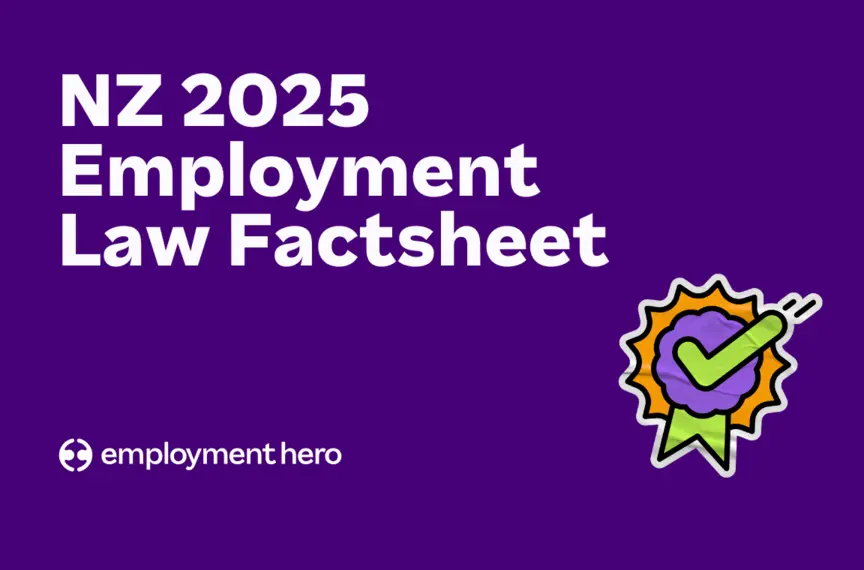HR metrics every NZ business owner needs to track
Published
HR metrics every NZ business owner needs to track
Published
If you’re looking to grow your business, it’s so important to understand where your business is performing well and where things can improve. We’re breaking down the HR metrics you need to track to understand your workforce. From demographics and hiring to performance, these numbers tell you the real story: is your team crushing it, or are they struggling?
That’s why we’ve created our digital guide, to take you through the key metrics and how to use them. The guide includes:
- The essential groundwork before collecting metrics
- The performance indicators that you should be tracking
- How to avoid potential pitfalls as you go
Download the guide to HR metrics by filling in the form on the right.
The value of HR metrics
HR metrics aren’t designed to replace regular feedback sessions or other methods of communication. Instead, they’re a way of benchmarking where your business is at, and how you can improve to make sure you meet your goals.
Tracking these metrics helps you and your leaders understand what direction you’re headed. That way, you can empower your workforce and make strategic decisions to grow with confidence.
Workforce structure metrics
Understanding the makeup of your current workforce and where you’re looking to grow can inform your short-term and long-term hiring strategies. These are some of the metrics that’ll help you understand your headcount, team composition and demographics, so you can easily identify strengths and areas for improvement.
Total staff count and composition
One of the simplest ways to understand your workforce is through total staff count. You should always track how many people currently work within your business, as well as types of workers, like full-time, part-time, casuals and contractors.
Diversity and demographic analysis
Doing a demographic analysis of your workforce will help you understand whether you’ve got a range of skillsets and perspectives. A demographic analysis involves mapping out your workforce’s attributes, including age, gender, race, religion, ethnicity and whether they have any disabilities.
It’s important to note that the New Zealand Human Rights Act prohibits workplace discrimination based on these protected attributes, including hiring based on any of these, unless it is a genuine requirement of the job. With that in mind, your demographic analysis is good to know but it shouldn’t influence your next hire.
Recruitment effectiveness metrics
Another area to keep an eye on is your recruitment. These metrics help you track whether your current approach to recruitment is working for you or whether you need to adjust your hiring processes.
Total talent acquisition investment
Tracking how much money you’re spending on overall recruitment can help you work out whether you’re currently recruiting effectively. If, for example, your recruitment costs are high but your turnover is also high, then it may be time to look at alternative means of hiring.
Per-hire investment analysis
It’s also worth breaking down your recruitment costs into a per-hire cost. If you’ve just gone through a hiring blitz then your total recruitment costs might be very high. However, your average per-hire cost may be quite low, showing that your recruitment method is actually quite effective.
Recruitment timeline efficiency
Do you find that you’re taking a while to fill key vacancies? Tracking the time it takes for you to hire for a role can help you determine whether you’re speaking to potential jobseekers in the right way, or if you need to shift your approach.
Position fulfilment speed
Sometimes, the onboarding process can lag, especially if you don’t have the right frameworks in place. Tracking how long it takes from posting a job to an employee starting, can help you identify gaps in your recruitment process.
New employee ramp-up period
Do your new employees take a while to hit the ground running? If you’re looking to work out where your onboarding process could improve, it’s worth tracking how long it takes new employees to reach full productivity within their role.
Early-stage employee departure rate
Some employees never truly get settled in their new role. If you’re looking to understand how many new hires turn into long-term employees, tracking attrition during an employee’s first year with your company can help you identify where key retention milestones might get missed.
Workforce performance indicators
Understanding your workforce’s productivity, and whether they’re hitting their goals, is one of the most important parts of running a business. Ultimately, a productive workforce is a successful workforce and it’s your job to spot where people are excelling – and where they need assistance.
Employee revenue generation
Tracking how your employees are contributing to revenue generation will help you see who’s making the most impact. Not every role will directly generate revenue, but this metric does help paint a picture of who’s shifting your business’ direction and who could make more of a difference.
Workplace attendance patterns
Absenteeism is one of the most reliable indicators that an employee is about to resign. Tracking workplace attendance patterns will help you identify who’s enjoying their time working for you and who needs more support.
Extended hours utilisation
Are your employees working overtime regularly? They may be overstretched and at risk of burnout. Understanding when and where you’re using overtime to meet deadlines can help you work out whether new hires are needed.
Performance targets achieved
Part of empowering your employees is getting them to set goals but once these goals are set, they need to be achieved. Tracking whether your employees are meeting their goals is an effective way of measuring their investment.
Employee experience and culture metrics
Are your employees really engaged with what your company’s looking to achieve? Employment surveys around engagement and wellbeing can help you track whether your employees understand your business’ vision, or they feel left on the outside.
Workplace satisfaction index
Regular workplace surveys can help you measure how much your employees actually enjoy doing their work. Enjoyment can affect productivity and turnover, so tracking workplace satisfaction can help you across the board.
Employee advocacy score
If you’re looking to find your next star employee, a recommendation from your current workforce might be the key. Understanding whether they’d recommend working for your business to someone else is a key indicator of your reputation amongst job-seekers.
Organisational mood assessment
Regular, more informal surveys can help you track shifts in morale amongst your workforce. They don’t have to be long and intense. Sometimes a few questions will show you everything you need to know to make a change.
Skills development and growth tracking
Tracking your workforce’s skills development and growth can help you identify who’s ready to take the next step in your business, and who needs a bit more assistance.
Whether you track their skills and progress informally, using a spreadsheet or other database, or whether you use comprehensive performance management software, is up to you.
There are a range of benefits to tracking skills development and growth:
- Making it easier to match employees with projects that’ll suit their skills
- Identifying who might be able to fill internal vacancies so you can promote from within
- Being able to pair up struggling employees with a mentor if there are particular gaps in their skillsets
- Using skills and growth data to justify workforce or department-wide training if you’re looking to invest in professional development
One of the most affordable ways to improve your workforce is to encourage internal skills development, rather than hiring every time you need to fill a skills gap. It also demonstrates to your workforce that you trust your team to take on further responsibilities once the time is right, which can help improve employee satisfaction.
This is where a learning management system is so useful, empowering your team to own their own development journey.
Talent retention analytics
Got the right people? Great. Now, are they sticking around for the long haul, or leaving after you’ve invested in them? These metrics tell the real story of your team’s commitment.
Workforce stability rate
Everyone wants a workplace where the team are happy to stick around for the long haul. Tracking average employee tenure can let you know whether people want to stay working for you or whether they get itchy feet quite quickly.
Replacement cost analysis
Replacing long-term employees can get expensive, especially if they take specialised knowledge with them. It’s important to understand the financial impact that turnover has on your business, so you can implement measures to counteract churn.
Departure reason intelligence
Sometimes, your leaving employees will be the most honest. Exit interviews are an important part of the offboarding process, as they can help you understand what led to their resignation.
Long-term employee retention
Want to know what parts of your business are most stable? Identifying high-retention roles or teams can help you dig deeper into what those functions are getting right, so you can replicate that across the board.
Download the HR metrics guide
Tracking HR metrics is one thing but understanding how they can inform your decision-making is another. In our free guide, we take you through how you can use these metrics to inform your strategic planning, so you can take your business forward.
Ready to get a better picture of how your business is truly performing?
Download HR metrics guide by filling in the form on the right.
Register for the guide
Related Resources
-
 Read more: Employment Agreement Checklist
Read more: Employment Agreement ChecklistEmployment Agreement Checklist
Creating your next employment contract? Download our free checklist to make sure you’re covering everything you need before onboarding.
-
 Read more: Employment law updates 2025
Read more: Employment law updates 2025Employment law updates 2025
Keep your business up-to-date with the latest changes in NZ employment law. Here’s what you need to know about the…
-
 Read more: Redundancy notice letter free template
Read more: Redundancy notice letter free templateRedundancy notice letter free template
Download your copy of the redundancy notice letter free template from Employment Law Experts now.





















